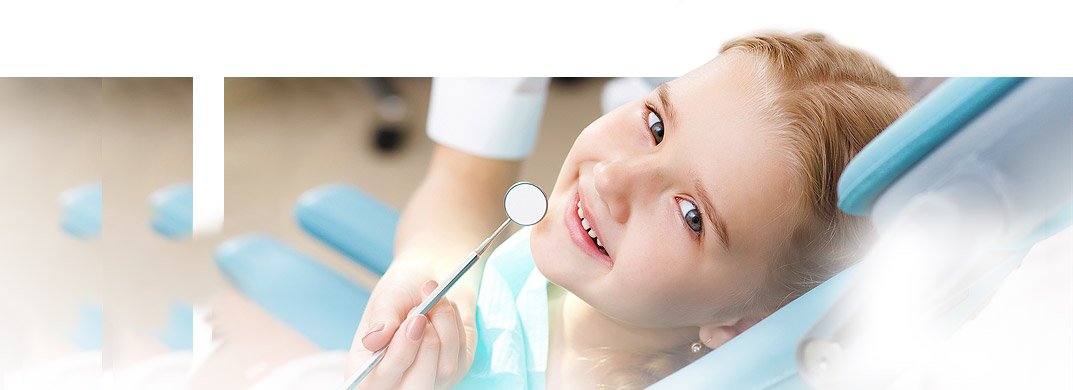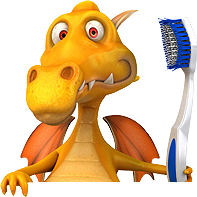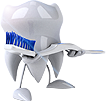FAQs

- When should the first visit to the dentist take place?
- What is different about your pedodontic practice than at my dentist?
- Why should baby or milk teeth (deciduous teeth) be repaired if they are going to fall out and be replaced by permanent teeth later?
- When are deciduous teeth lost?
- Can baby teeth cause pain?
- When should we start with oral hygiene?
- Our child still sucks a bottle, pacifier or thumb, is this harmful?
- What is prophylaxis (cleaning) for children?
- What is nutritionally sound for children’s teeth?
When should the first visit to the dentist take place?
- Most dentists recommend the first visit to the dentist be around the age of three. The child can get used to the dental practice gently.
- We recommend the visit be after the first year.
- The goal is to give you, the parents, guidance in giving your child the best oral care possible. Unfortunately, in Germany 20% of the toddlers show carious lesions long before their third birthday. We can also discuss questions about using a pacifier, baby bottle, fluorides and tooth alignment during this early dental appointment.
- With regular follow-up visits twice a year, we can build up a positive relationship with your child, recognize problems early and solve them a lot easier. Your child will love to come back and not will going to the dentist because it has a „hole“.
What is different about your pedodontic practice from my dentist?
- In our practice children are the center of attention and their well-being is our main focus. All of the dentists and the entire team are specially trained to treat children and the operatories are set up exclusively for young patients. Consequently, we can offer a variety of treatment methods to give your child the best treatment possible.
- Starting with a caring, child-appropriate behavior management we can also offer hypnosis and sedation with phobia- reducing medication. In very young patients with problems, dental treatments can also be done under full anesthesia performed by experienced by pediatric anesthesiologists. No two children are alike. The method that is best for your child can be determined during our first consultation appointment.
- In our practice your child can feel comfortable, develop a positive attitude toward dental treatments and, if necessary, regain the trust that may have been lost in the past. Our emphasis is high quality treatment to help your child keep a bright and healthy smile all the way to the last baby tooth, giving him the best foundation for a healthy mouth in the future.
- We look forward to welcoming your child into our practice and accompanying him/her from the first to the last deciduous tooth.
Why should deciduous teeth be repaired if they are going to be lost and replaced later?
- Unfortunately, the widespread opinion that baby teeth are not important because they are eventually lost is, from a dental standpoint, absolutely wrong! Healthy baby teeth are important! Children need these teeth to chew, speak and, last but not least, to laugh. And that for longer than most people realize. Although front teeth are lost around the age of 6, the molars are usually not lost until the age of 12.
- During this time milk teeth are important space-keepers for the permanent teeth that follow. Losing a milk tooth early can cause loss of space for the permanent teeth and this can often only be corrected by expensive and troublesome orthodontic treatment.
- However, inflamed and dead milk teeth are not healthy space-keepers. Destroyed, irreparable teeth need to be removed in order avoid burdening the immune system and allow the oral flora to return to a healthy balance.
- In such a case we would construct a space-saver that is not only hygienic but prevents unnecessary malalignment of the permanent teeth.
- Caries in deciduous teeth can cause pain and inflammation just as in permanent teeth. This can be avoided by early detection and competent treatment. Besides, deposits occur more readily on carious milk teeth, allowing caries bacteria to multiply and carry over to healthy teeth and jeopardize permanent teeth just breaking through the gums.
- A healthy and complete deciduous dentition is the best foundation for healthy permanent teeth and a confident smile from the first to the last tooth. We can help your child through periodic cleanings and early detection examinations. This is state of the art pedodontics!
When are baby teeth lost?
- Generally, the first baby teeth (the front teeth) are lost between the ages of 5 to 7. What most people don’t realize is that the baby molars are not replaced by permanent teeth until the ages of 10 to 12. Some children lost their teeth earlier and just as many others who lose them later.
Can baby teeth be painful?
- Yes, of course. Baby teeth are similar to permanent teeth in their make-up, meaning with roots and nerves. Treating baby teeth is only pain-free with local anesthesia unless it is only a minimal surface lesion. If the cavity is large, it is often very painful for the child and the tooth can become abscessed and cause facial swelling.
When should we start with oral hygiene?
- Oral hygiene should start as soon as the first tooth appears. In the beginning it is enough to clean with a soft cloth or cotton swab.
- We recommend a pea-sized amount of children’s toothpaste containing fluoride (500 ppm fluoride) twice a day as of the age of 2 years. At this point, stop using the fluoride tablets (in German Fluoretten) if they were prescribed by your pediatrician. After the age of 6 or as of the appearance of the first permanent tooth, your child should use a toothpaste with higher fluoride concentration (1000-1500 ppm fluoride).
- Fluoride makes the enamel of the tooth more resistant to demineralization by food and helps to remineralize surfaces that may have been weakened. Regular use of fluoride-containing toothpastes is particularly good caries prevention.
Our child still uses a pacifier or sucks his/her thumb. Is this harmful?
- If a child sucks frequently, whether pacifier or thumb, over a longer period of time, malalignment can be the result, specifically an ‘open bite’ where the upper and lower front teeth can no longer touch. This in turn can cause problems biting off foods and the tongue tends to slide to the front and certain sounds cannot be pronounced. The s, z, and sh sounds cannot be pronounced clearly and the child lisps.
- Between the ages of 3 and 4 most children are willing to give up a pacifier. Thumbs and fingers often take much longer.
- We can help you find solutions to these problems.
What is prophylaxis for children?
- We call this our “Brushing School for Kids”. Our professionally trained prophylaxis team will show your child how to keep his/her teeth clean independently and effectively.
- Then the teeth will be cleaned gently and thoroughly and fluoridated. If necessary, the molars will be treated with a pit and fissure sealant.
- This is not only good for their teeth, but this is a wonderful way for children to become accustomed to the dental equipment (Schlürfi , the water pistol, cotton rolls) and the noises. Children learn to trust the dental office environment and associate it with a positive experience. It’s fun, it motivates to keep their teeth healthy and it has nothing to do with “drilling”….
- In children with rampant caries, we recommend prophylaxis 3 to 4 times a year. The insurances will pay for cleanings twice a year. Preventive care in children is easier and pleasant than treating rotten teeth!
What is nutritionally sound for children’s teeth?
- Caries can only develop if the pathogens (or germs) are able to attack the surface of the tooth often enough and there is no time for regeneration. If a child sucks a bottle with juice or sweetened tea all day or even at night, the teeth are permanently confronted with bacteria and high caries risk is the result.
- More important than low sugar nutrition is limiting sweet and acidic drinks. This includes drinks that are marked ‘no sugar added’ because these often contain large amounts of fructose! You can give your child sweet or acidic drinks with meals twice a day.
- The rest of the day you can give your child water to drink. Unfortunately, once they have gotten used to sweetened drinks, many children won’t drink water. Sometimes you have to resort to little tricks and tips to get children to drink water again. We will be glad to help you!
Termin online vereinbaren






